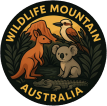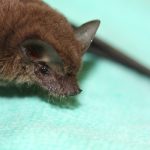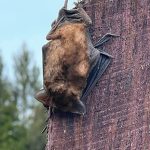EASTERN FREETAIL-BAT
The Eastern Freetail Bat – A Master of the Night Skies
The Eastern Freetail Bat is a small to medium-sized microbat, measuring just 5 to 6 centimetres in body length, yet boasting an impressive wingspan of up to 30 centimetres. Its slender, aerodynamic frame is cloaked in short, velvety fur that glimmers in shades of greyish-brown under moonlight. One of its most distinctive features is the tail, which extends freely beyond the thin skin of the tail membrane—an adaptation that gives rise to its common name, freetail. Large, alert ears crown its head, finely tuned to detect the faintest echoes in the dark.
Habitat and Range
The Eastern Freetail Bat is most at home along the eastern seaboard of Australia, from southern Queensland through New South Wales and into Victoria. Here, it roams over a patchwork of open forests, woodlands, and mixed tree–grassland environments, where the spaces between tree canopies allow for swift, agile flight.
On a warm evening, you might see them silhouetted against the twilight sky, weaving through open spaces while scanning the air for the flutter of insect wings. In urban areas, they sometimes adapt by foraging near streetlights, where moths and beetles gather.
Diet and Hunting
The Eastern Freetail Bat is an insectivore, feeding on a diverse menu of nocturnal flyers, including moths, beetles, and other winged insects. Its hunting success relies on echolocation—a biological sonar system.
By emitting a series of rapid, high-frequency clicks (mostly beyond human hearing), the bat listens for echoes that bounce off objects and prey, creating an acoustic map of its surroundings. In complete darkness, this allows it to pinpoint a single moth mid-flight and snatch it from the air with remarkable precision.
Breeding and Social Life
Breeding takes place during the warmer months—from spring into early summer. Females typically give birth to a single pup, which they raise in maternity colonies. These colonies often form in tree hollows, beneath loose bark, or occasionally in man-made structures, offering a secure refuge from predators and the elements.
Inside a maternity roost, the air is warm and filled with the soft rustle of wings, the faint chatter of social calls, and the occasional squeak of hungry young. Mothers nurse their pups until they are strong enough to take to the skies, often within just a few weeks.
Lifespan and Behaviour
In the wild, the Eastern Freetail Bat can live for several years, though survival depends heavily on the availability of safe roosting sites and abundant food. Their behaviour is a blend of efficiency and agility—high-speed, direct flight makes them superb long-distance foragers. Unlike some other bats, they often fly high above the tree canopy, exploiting a hunting space with fewer aerial competitors.
Threats and Conservation
The Eastern Freetail Bat is currently listed as Near Threatened, with habitat loss and fragmentation being the greatest dangers. Expanding urban areas, deforestation, and the removal of old trees with natural hollows reduce both their food supply and roosting sites.
Conservation strategies focus on:
- Protecting old-growth trees and natural roosting sites
- Restoring woodland habitats in their range
- Educating communities about the ecological benefits of bats
By protecting the Eastern Freetail Bat, we also safeguard the balance of insect populations and contribute to the health of Australia’s ecosystems.
The Sound of the Night
While their echolocation calls are generally ultrasonic, beyond the range of human hearing, these bats also make audible social calls—short, high-pitched chirps—especially when gathered in colonies or during courtship. Listening devices called bat detectors can translate their ultrasonic calls into sounds we can hear, opening a window into their hidden acoustic world.
Why They Matter
The Eastern Freetail Bat is more than just a fascinating nocturnal hunter—it is a vital pest controller, consuming thousands of insects each night. By learning about and protecting them, we protect the intricate connections that keep our environment healthy and resilient.
Did you know?
A single Eastern Freetail Bat can eat half its body weight in insects in one night—a natural service that benefits both agriculture and human comfort.




